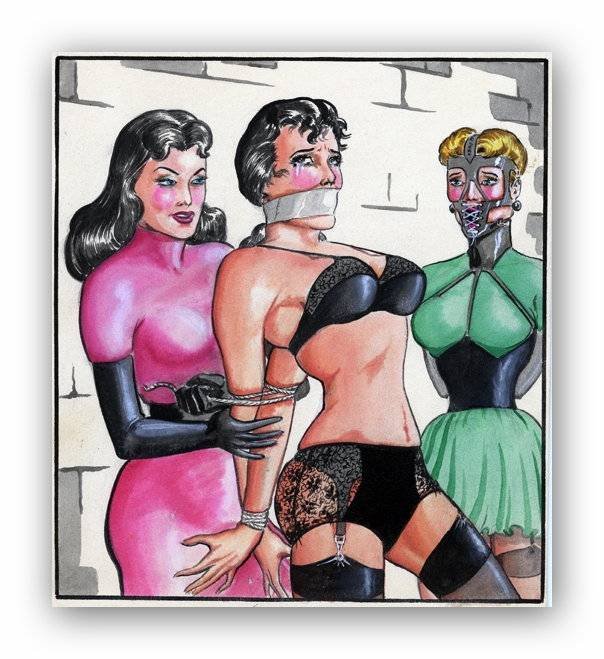No products in the cart.
BDSM Comics
Unleash Your Inner Kink with the Art of Eric Stanton – A Tribute
Welcome to a world where eroticism meets art. Eric Stanton, the renowned American illustrator, was known for his kinky illustrations that explored the boundaries of desire and passion. His work continues to inspire and titillate audiences today, as we explore the depths of our inner kink.
Through his art, Stanton challenged societal norms and expectations, pushing boundaries and exploring taboo topics such as BDSM and power dynamics. He created a world where sensuality and fetishism reigned, where strong, dominant women were celebrated and empowered.
In this tribute to Eric Stanton, we will delve deep into his life, his art, and his impact on popular culture and beyond. Join us as we explore the unique artistic style of Eric Stanton, his passionate erotic world, and the evolution of fetish art. Get ready to unleash your inner kink and discover the art of Eric Stanton.
Who was Eric Stanton?
Eric Stanton was an American artist born in Brooklyn, New York, in 1926. He started his career in the 1940s, working for several publishers as a comic artist, illustrator, and cover designer. His early work was mainly focused on adventure stories and romance comics, but he later turned his attention to fetish art, exploring themes of BDSM and female domination.
Stanton’s fetish art brought him recognition, and he became known as one of the most influential artists in the genre. His works were often humorous and cartoonish, with exaggerated shapes and proportions that added to their erotic appeal. The women in his illustrations were strong, confident, and dominant, breaking away from the traditional gender roles of the time and empowering female sexuality.
Stanton’s influence on the art world is still felt today, and his artwork continues to be celebrated by fans of erotic art and fetish culture. Despite facing censorship and social stigma, Stanton remained true to his artistic vision, paving the way for future generations of artists to explore taboo themes and push boundaries with their work.
The Artistic Style of Eric Stanton
Eric Stanton’s artistic style is unique in its ability to blend cartoonish illustrations with erotic themes. His work is known for its bold, unapologetic approach to fetish art that challenges societal norms and expectations.
Stanton’s illustrations often feature highly sexualized images of men and women engaged in BDSM and other fetish activities. However, what sets his work apart is the way he portrays these taboo subjects with a sense of humor and playfulness. His drawings are often caricature-like, with exaggerated features and playful expressions that add to their eroticism and appeal.
In addition to his use of humor and cartoonish visuals, Stanton’s work features a distinct use of color and shading that adds depth to his illustrations. His attention to detail is also noteworthy, with intricate depictions of clothing, accessories, and equipment that make his scenes feel incredibly realistic.
Stanton’s artistic style has had a significant impact on the world of fetish art, inspiring numerous artists to explore new ways of blending humor, eroticism, and taboo subjects in their work. His legacy continues to be felt today as artists continue to push the boundaries of what is considered acceptable in erotic art.
The Erotic World of Eric Stanton
Eric Stanton’s artwork is a celebration of sensuality, desire, and fetishism. His illustrations tap into our deepest desires and fantasies, exploring the erotic world in a way that is both playful and provocative.
Stanton’s art is characterized by its unique depiction of power dynamics, BDSM, and fetishism. He blends eroticism with humor and cartoonish illustrations, creating images that are simultaneously arousing and lighthearted.
His work is a celebration of sexual diversity and exploration, challenging societal norms and expectations, and pushing boundaries in a way that is both liberating and empowering.
Stanton’s art captures the essence of passion and desire, inviting the viewer to explore their own innermost desires and to embrace their kinky side.
“I draw because I enjoy it, I enjoy because it’s in me, and for no other reason.”
Eric Stanton
Stanton’s erotic world is a world without judgment or shame, where everything is accepted and embraced. His art is an invitation to unleash your inner kink and to explore the depths of your own passion.
Whether it’s through his depictions of strong, dominant females or his playful illustrations of BDSM and power dynamics, Stanton’s work is a celebration of sexuality and eroticism, inspiring us to embrace our own desires and to explore the boundaries of pleasure.
Exploring Boundaries with Eric Stanton
Eric Stanton’s artwork is known for pushing boundaries and exploring taboo topics. His depictions of BDSM and power dynamics challenge societal norms and expectations, inviting viewers to explore their own desires and fetishes.
“[Stanton’s] art was so powerful and so filled with erotic potential that it couldn’t help but open up new horizons for sexual expression, establishing contexts within which BDSM could be explored with creative passion, genuine trust and mutual respect.” – John Sutcliffe, fetish fashion designer and publisher of AtomAge magazine.
Stanton’s illustrations often feature dominant females, as well as strong male and female figures who embrace their sexuality and express their desires without shame or hesitation. By breaking down gender stereotypes and traditional power dynamics, Stanton’s art encourages viewers to embrace their own sexual identities and explore their boundaries.
One of the reasons Stanton’s work resonates with so many people is his ability to evoke strong emotions and sensations through his art. His illustrations are not only visually stimulating, but they also tap into our deepest desires and fantasies, inviting us to explore the unknown and embrace the unconventional.
For those who are interested in BDSM and fetishism, Eric Stanton’s art serves as a powerful tool for self-discovery and exploration. By daring to explore taboo topics and push societal boundaries, Stanton’s work has left a lasting impact on the world of erotic art and beyond.
Eric Stanton and Female Empowerment
One of the most notable aspects of Eric Stanton’s art is his depictions of strong, dominant women. These women are often the ones in control, whether it be in a BDSM scenario or simply in their everyday lives. Stanton’s artwork can be viewed as empowering for women, as it challenges traditional gender roles and stereotypes.
His female characters are confident, assertive, and unapologetic about their desires. They are not objects to be acted upon, but rather active participants in their own pleasure. This portrayal of women as powerful and self-assured is still radical even today, making Stanton’s art all the more important and relevant.
Stanton’s female characters also often embody different archetypes, ranging from the classic dominatrix to the powerful businesswoman. This variety showcases the many different ways in which women can be strong and dominant, breaking down any narrow definitions or limitations.
It’s worth noting that while some may view Stanton’s artwork as objectifying women, it is important to recognize the agency and autonomy that these characters possess. They are not simply there for male pleasure, but rather exist as fully realized individuals with their own desires and motivations.
Overall, Eric Stanton’s art celebrates female empowerment and challenges societal norms, making it a powerful tool for anyone seeking to embrace their own inner strength and confidence.
Impact on Pop Culture and Beyond
Eric Stanton’s artwork has had a significant impact on popular culture and beyond. His unique artistic style and taboo subject matter have made him an icon in the world of fetish art, influencing many artists who followed in his footsteps.
Stanton’s art has been featured in galleries and museums around the world, cementing his legacy as one of the greatest erotic artists of all time. His work has also been adapted into other forms of media, including film and literature.
One notable example of Eric Stanton’s influence can be seen in the work of Robert Crumb, who is known for his underground comic books. Crumb cites Stanton as one of his major influences, and there are clear similarities in their art styles and subject matter.
Stanton’s impact on popular culture can also be seen in the way that his artwork has been referenced and reproduced in television shows, movies, and music videos. For example, his illustrations have been used as set decor in TV shows like Mad Men, and his artwork has been featured in music videos for artists like Iggy and the Stooges.
Overall, Eric Stanton’s impact on pop culture and beyond cannot be overstated. His contributions to the world of fetish art have inspired countless artists and have solidified his place in history as one of the most important erotic artists of all time.
The Evolution of Fetish Art
At its core, fetish art is about exploring the taboo and pushing boundaries. Throughout history, there have been countless examples of this type of art, from the erotic statues of ancient Greece to the BDSM photography of the 20th century. However, it wasn’t until the 20th century that fetish art truly began to flourish as a distinct genre.
One of the earliest examples of modern fetish art can be found in the work of John Willie, who is often credited with popularizing the “bondage and discipline” (BD) subculture. Willie’s illustrations often depicted women in tight, restrictive clothing and ropes, and his work was a precursor to the BDSM art that would follow.
The 1960s and 70s saw a significant increase in fetish art, with artists like Eric Stanton producing work that explored power dynamics, dominance, and submission. Stanton’s art, in particular, stood out for its unique blend of cartoonish illustrations with erotic and fetishistic themes. His work inspired a new generation of artists and helped shape the fetish art genre.
In recent years, fetish art has continued to evolve alongside changes in society’s attitudes towards sexuality. While once considered taboo and underground, fetish art has become more accepted and mainstream, with artists like Hajime Sorayama and Julie Bell gaining wider recognition.
Despite this increased visibility, fetish art remains an important genre for exploring sexuality and desire. It continues to push boundaries and challenge societal norms, and artists like Eric Stanton are part of the legacy that has made this possible.
Frequently Asked Questions (FAQ)
Here are some commonly asked questions about Eric Stanton’s artwork:
Where can I purchase Eric Stanton’s artwork?
Eric Stanton’s artwork can be purchased through various online galleries and auction sites. Some popular options include eBay, Heritage Auctions, and The Erotic Art Gallery.
How do I start a collection of Eric Stanton’s artwork?
Starting a collection of Eric Stanton’s artwork can be a fun and exciting process. One way to begin is by researching his pieces and deciding which ones you are most drawn to. You can also attend art auctions and browse galleries to find pieces that fit your interests and budget.
What should I expect to pay for Eric Stanton’s artwork?
The price of Eric Stanton’s artwork can vary depending on factors such as the rarity of the piece, its condition, and where it is being sold. Some pieces can sell for a few hundred dollars, while others can go for thousands.
What makes Eric Stanton’s artwork unique?
Eric Stanton’s artwork is unique in its depiction of fetishism and the exploration of power dynamics in relationships. His cartoonish style adds an element of playfulness and humor to his pieces, while still maintaining a strong sense of eroticism.
Is Eric Stanton’s artwork considered mainstream?
While Eric Stanton’s artwork has gained a following over the years, it is still considered taboo and not widely accepted in mainstream culture. However, his impact on the world of erotic art cannot be denied and his work continues to be appreciated by those with a taste for the unconventional.

